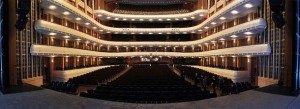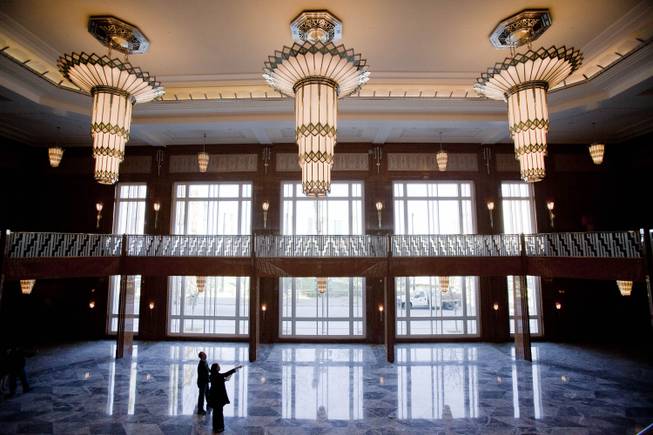The photo was pretty astonishing, and so was the pricetag: $470 million. As I caught up on newspapers I’d missed while I was away last week, I came upon an article in last Sunday’s New York Times headlined Las Vegas Becomes As Much Liszt as Liberace, illustrated by a gorgeous interior photograph of the city’s new performing arts center.
I’ve written here several times about the lack of an art museum in Las Vegas, a city of 1.8 million people and plenty of tourists. The Las Vegas Art Museum closed for lack of interest in early 2009; a proposed contemporary art museum was abandoned even while the designated sculpture park sat empty; plenty of money was going instead to two museums about the Mob in Vegas; and the Southern Nevada Museum was getting just a handful of visitors a day — ok, two to three handfuls. (See also here.)
So the idea of a center for classical music in this city that lacked one caught my attention.
 After my posts on the museum situation in Las Vegas, commenters had often written in to make excuses, some valid. Last June, following the post about the Southern Nevada Museum, one commenter noted that Las Vegas residents are often transients, aiming to move in a few years and unwilling therefore to invest in cultural activities in the community. Another said visitors to Las Vegas are not interested in art. And another wrote:
After my posts on the museum situation in Las Vegas, commenters had often written in to make excuses, some valid. Last June, following the post about the Southern Nevada Museum, one commenter noted that Las Vegas residents are often transients, aiming to move in a few years and unwilling therefore to invest in cultural activities in the community. Another said visitors to Las Vegas are not interested in art. And another wrote:
It’s hard to get public support for the arts in Nevada. NV is a state with little public funding of ANYTHING, even when the economy is good….
How to square that with the Times article, which included these passages:
When the Smith Center for the Performing Arts opened in Las Vegas in March, Jennifer Hudson was on the program and Neil Patrick Harris was the master of ceremonies. But it was Joshua Bell, the classical violinist, who drew the most applause from the homegrown audience, cheering what seemed a moment of arrival for a city whose cultural association is more likely to be Liberace than Liszt.
…For more than 25 years, Las Vegas has laid claim to being the entertainment capital of the nation. But it has presented a very specific kind of entertainment — elaborate, mass-market, big-ticket showstoppers like Cirque du Soleil, Elton John, Celine Dion and Siegfried & Roy. And it has been aimed at a very specific audience: tourists who come to the Strip, as opposed to the people who live here.
Las Vegas had the unwelcome distinction of being the largest city in the nation without a major performing arts center.
Sounds familiar. So how did this supposed cultural wasteland get a $470 million performing arts center?
…A delegation of Las Vegas civic leaders toured concert halls around the world — La Scala in Milan, the Opera House in Budapest, Carnegie Hall in New York — in search of inspiration as they conceived what was in effect their dream hall….
The financing of the project suggests the civic hunger: $150 million was donated from the Donald W. Reynolds Foundation, a philanthropic organization in Nevada whose president is Fred W. Smith, a retired newspaper executive and for whom the center is named. Fifty-seven families and individuals wrote checks of at least $1 million. Another $150 million is to be raised through a tax on airport car rentals, approved by the State Legislature….
The Smith Center looks beautiful — check out the slide show run by the Los Angeles Times last March, as well as the photos here.
So why can the performing arts raise money but not the visual arts? I suspect one reason is the edifice complex: donors will give to build a building, especially if some hall, some rehearsal space, some staircase, is named for them. But why the rental tax for this and not for art? Where is the hunger for great visual art?
Of course it remains to be seen if the likes of Joshua Bell and Yo-Yo Ma continue to sell out, or whether the Smith, like some other performing arts venues, is forced to go pop. I’m rooting for classical. Perhaps a successful track record will convince civic leaders that a city as big as Las Vegas must also elevate its visual art offerings.
Photo Credit: Courtesy of Las Vegas Weekly (top) and Las Vegas Sun (bottom)

